c o m i n gx i n t ox b e i n g |
part one of six - January 2007 |
| Now the work shifts and the pace changes. The first 6 month period of any NavCenter is a critical time as this is when the basic patterns are set down. No matter how much design and preparation goes into the design and building of a NavCenter, the living reality always surprises and offers the owner-user new insights of the possible. It is important to develop along the path of these new insights not only upon the more limited concepts that served to launch the project in the first place. |
| Now that the NavCenter, in the physical sense, is a built reality, the full impact of not only what it is and can do - but also what it will take to operate it - becomes more clear to everyone. Usually, this comes as a bit of a shock. As many Centers as I have built, I still find this somewhat startling. NavCenters pay back their investment big time but they require a very large up front investment of time, energy and money. Knowledge factories are capital expenses as are their industrial counterparts - NavCenters cannot be confused as “offices.” You can and should office in them but not in the way that a traditional space is employed. |
|
...03 Jan/ to 21/Jan/07
Finishing the Construction |
| The first tasks of this month remained primarily finishing the construction work sufficiently to hold the Senior Leadership meeting. This was not an easy task and the work continued down to the last hour. This work was chronicled starting with parts seven and eight of the “coming into being” narrative [link: becoming part #7. In parallel with this the construction work, the opening events were used to start the process of MG Taylor Method transfer and to organize the NavCenter and the rest of the Unimanagement facilities for ongoing operations. At this objective we were moderately successful - by the time we had fully gathered the staff and KnowledgeWorker team the work necessary to prepare the opening event was an almost overwhelming task. This was a complex event with nearly 400 participants and 75 staffing about 25 of which were experienced. The event went well and managed to provide a taste of the coming capabilities of the UniManagement Center. This is not the way I would have chosen to introduce the NavCenter nor the Learning Lab to the UniCredit community but I think we did avoid sending the message that this was a conventional large group meeting space with a whole bunch of fancy, expensive features that really are not needed. Until we do a high stakes collaborative event on a critical issue, it will not be easy to understand why this space was designed as it was. The possibility of such an event still remains a few months in the future. |
...Week One - 21/Jan to 27/Jan/07
Beginning |
| My first week, post opening, was largely a return to SCAN by participating at the WEF Annual Meeting at Davos. This facilitated my regaining some perspective on the UniCredit design/build experience. Seeing the WEF team running the WorkSpace on their own provided encouragement in regards the transfer process ahead at UniCredit. This also gave me an updated sense of how the NavCenter network and idea of Worthy Projects fits in the present social reality. It looks to me that the window for real global transformational work is opening - and fast. This has direct bearing on the UniManagement venture and how its resources are organized. |
DAVOS 07 was my first experience, since 01, as a full participant with no responsibilities other than being there. The WORKSPACE - now with two rooms - did very well al on its own and I attended one session on the design of Eco-Cities. This was a benchmark for me: sitting in a space we designed, with our process being employed, at a world class meeting with very bright people discussing the criteria and principles of the design of future sustainable cities. Many of the those attending are actually engaged in the production of such cites in China and elsewhere.
This is a different world than when we did our first session - in this very room - sans any environment or KnowledgeWorkers - seven years ago. Several of the topics at Davos this year were Worthy Projects [link: worthy problems] material. For the first time, we see a measure of anticipatory design [link: a future by...]. This took a generation, but here we are.
It was fun to meet and dialog with old friends such as Emory Lovins, John Gage and Peter Schwartz. I have known Emery and Perter since the 1970s and have followed their work ever since. It was John who first recommended us to the Forum after the 1998 Hypercar DesignShop. |
|
|
|
|
|
| I suppose this is a good time to reflect on both the social change process and the time it takes to incubate an idea and to build it - and, the nature of social credibility and the uses of fame. |
| I have never worked to established social credibility. As a matter of fact almost every step I have taken, in my 50 years of work, has progressively moved me away from any traditional channels of such recognition. This has no doubt made the advancement of my ideas and work more difficult. On the other hand, I am totally free from certain social debts and obligations - I am “owned” by no one. I am able to take any stand I find necessary without fear of loosing privilege, income or status. After a generation, the ideas upon which MG Taylor was founded are just now becoming topics of polite conversation in credible circles. My voice is now accepted - with some reservation to be sure - in some of these circles. The UniCredit project took 6 months of my time over the period of a year - one percent of my total professional effort to date. It will take 30, 40 or 50 of these NavCenters - all networked - plus a Xanadu to create the infrastructure I believe necessary to do the social-scale, anticipatory-design, engineering and building necessary to resolve systemic global problems. Global Warming, as example just became credible over the last year. This took a hundred years from the first time this question was scientifically addressed. There are many incremental, already known things we can do to arrest human contribution to the warming of the planet. If they will be done or not - by all nations - is still an open question. What we do over the next several years is critical in terms of the outcome. The systemic consequences and responses to Global Warming - nature made and man made as both are happening - remain un addressed. To take a year to create a world class NavCenter is not unreasonable. A viable network of Centers is still a nascent idea. It took 18 months and four DesignShop® events to “solve” the F-15 production issues - the most complex system we have addressed to date [link: rutley - f-15 results]. Does any of this add up? This in itself is a Worthy Problem. I have been running this race with the future since 1975 and I feel like I am about where I was then. Much more tooled-up, that is for sure, but a generation has passed up by. maybe this is how it is supposed to be. |
...Week Two - Jan 28/ to /Feb/07
Introductions |
| There were two “first” events in the NavCenter this week The first was the introduction of UniManagement to the city of Torino and the second was the first design session done in the NavCenter and conducted by the Unimanagement staff. The celebration with the city went very well and the Unimanagement facility was well received. |
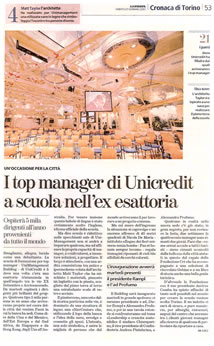 |
aaaaa
click on the graphics
for full size
|
|
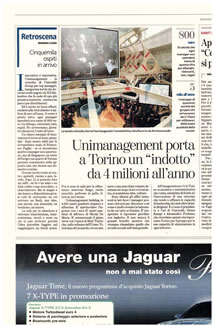 |
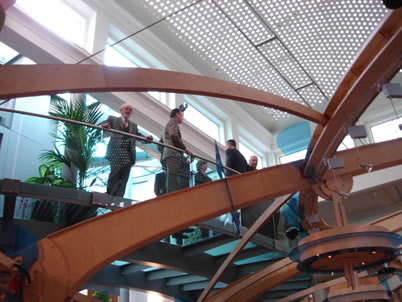
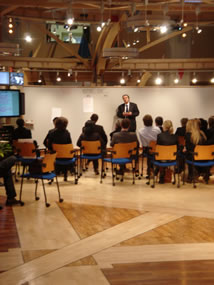 |
The final report out of a design session day facilitated by the UniManagement staff. This was the first use of the NavCenter for its intended use. I came end at the end of this process and shot these photos. It was one year ago, after Davos 06, that I started the design work on this project and two years since the Armature was partially use at Davos 05.
After this session Lisa, Anna and I had a brief, but unhurried, dialog about the next several months and the transfer process. This was our first opportunity to look to the future, in nearly a year, without a deadline hanging over our shoulder. It was also the first time that I sat at a table and used a WorkWall, in the space. The USE process begins.
Mike was finishing up his work, today, for this trip. He will be back in about a month to install the final items which are now being manufactured. There remains many small details a a couple of new items such as the TechiRovers which will bring lighting, power and technology to the peripheral areas. |
|
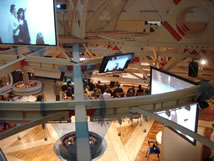 |
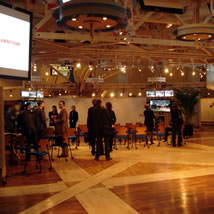 |
| The photos, below, were taken by me on the morning of the the 1st of February. I came to the Center on my way to the train to Zurich to meet with Massimo Maffei - the head of the Unicredit media team - and Jeff Schultz a ValueWeb KnowledgeWorker who has stayed on since the Leadership Meeting on the 18th of January. Massimo and I discussed the ongoing development of the multimedia capability while Jeff started organizing the first setups of the NavCenter as it will actually be used 90% of the time. This provided us our first “look” at the space organized for the number of people and work areas as it was designed to provide. The space opened up considerably as over 200 chairs were banished to the basement. |
|
| As I write this, I am on the train to Zurich to fly to Barcelona in the morning for a few days of re-creation, with Gail, and to see the works of Gaudi. After three months of creative tension, I can now feel both relaxation and satisfaction. The last two weeks have convinced me that this work will be accepted and used as it was designed to be employed. I never doubted that people would like it as architecture as architecture is generally appraised. My concern has been if the USE of Design/Build/Use of this practice would take hold. It is this aspect of my approach to practice [link: thesis - making authentic architecture] that is the most radical yet and therefore the most difficult to get accomplished. The deadline which drove the design-build process of this project left little bandwidth on the part of the client to think beyond the opening ceremonies. However, now that these events are behind us, this has changed and a true program of transfer and use is now being planned. |
| Beyond this renewed focus on the NavCenter’s program is a greater source of confidence. Seeing the progress at the WEF over the last year and listening to the Torino leaders expressing their concerns and ambitions for their future leads me to believe we have delivered the right capability to the right place at the right time. There is work ahead and no doubt speed bumps in the road. This is just part of the work. What is important is that the opportunity is real. That here there are people who are beginning to embrace systemic problems as such and who are not looking just for the easy fix. |
| This confidence allows me to enjoy the NavCenter as a work of art and relax with this aspect of the achievement. The environment is yet to be fully experienced, at least, it now can be seen for what it might become. Just getting it built was a significant effort and achievement. Bringing it to its full level of use and expression will be a greater one. I am looking forward to this challenge. |
|
|
| GoTo: UniCredit Handwritten Notebook |
|
|
|
|
| GoTo: Unicredit NavCenter Tour |
|
|
|
Matt Taylor
Davos
January 25, 2007

SolutionBox
voice of this document:
BUILD • TACTICS •
EVALUATION
|
posted:
January 25, 2007
revised:
February 6, 2007
• 20070125.731019.mt • 20070201.980110.mt •
• 20070105.111100.mt • 20070106.989801.mt •
(note:
this document is about 96% finished)
Copyright© Matt
Taylor 2007
|
|
|